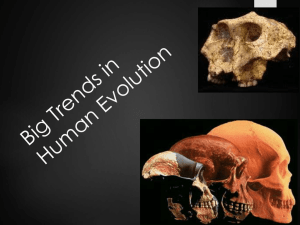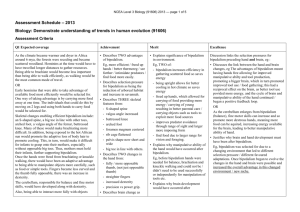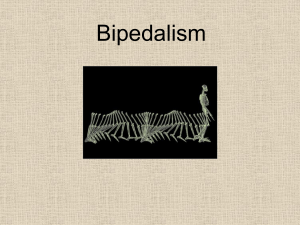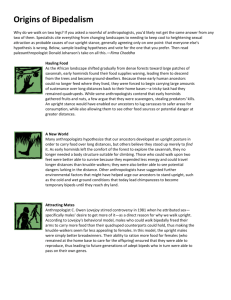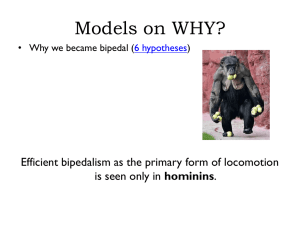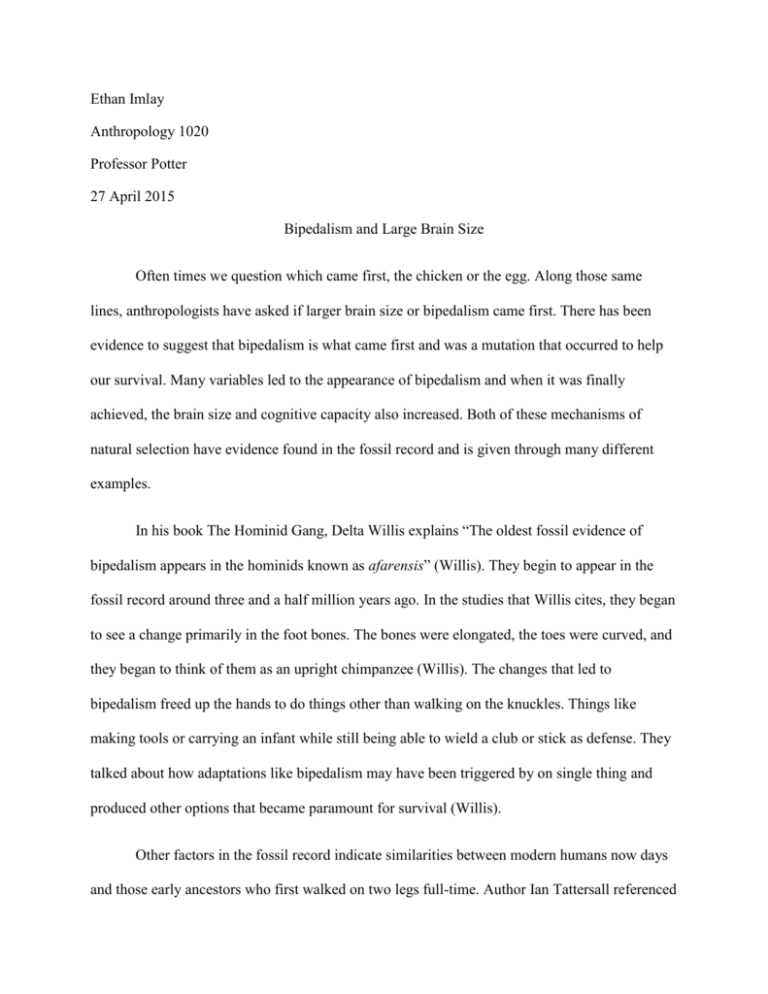
Ethan Imlay
Anthropology 1020
Professor Potter
27 April 2015
Bipedalism and Large Brain Size
Often times we question which came first, the chicken or the egg. Along those same
lines, anthropologists have asked if larger brain size or bipedalism came first. There has been
evidence to suggest that bipedalism is what came first and was a mutation that occurred to help
our survival. Many variables led to the appearance of bipedalism and when it was finally
achieved, the brain size and cognitive capacity also increased. Both of these mechanisms of
natural selection have evidence found in the fossil record and is given through many different
examples.
In his book The Hominid Gang, Delta Willis explains “The oldest fossil evidence of
bipedalism appears in the hominids known as afarensis” (Willis). They begin to appear in the
fossil record around three and a half million years ago. In the studies that Willis cites, they began
to see a change primarily in the foot bones. The bones were elongated, the toes were curved, and
they began to think of them as an upright chimpanzee (Willis). The changes that led to
bipedalism freed up the hands to do things other than walking on the knuckles. Things like
making tools or carrying an infant while still being able to wield a club or stick as defense. They
talked about how adaptations like bipedalism may have been triggered by on single thing and
produced other options that became paramount for survival (Willis).
Other factors in the fossil record indicate similarities between modern humans now days
and those early ancestors who first walked on two legs full-time. Author Ian Tattersall referenced
the Afarensis fossils and a very famous fossil named “Lucy” when he explained the move from
the forest to the open ground. He said, “Life would have been dangerous away from the forest
for small-bodied and relatively slow-moving creatures such as these, and it would be surprising
if they had not regularly sought the shelter of their former home. ‘Lucy’ and her like were
equipped with a basic adaptation that has subsequently proven, albeit in refined form, highly
efficacious out on the savanna (Tattersall). These findings prove that bipedalism was certainly a
function of natural selection. While standing upright, one looks larger and less like a small prey
animal. Predators are often triggered by the horizontal silhouette in a way they aren’t by a
vertical one. You also extend your horizon and can see over tall grass in search for either food or
predators (Tattersall). Thus we see that natural selection uses these adaptations to the advantage
of those who develop them.
Walking habitually on two feet represents a fundamental change from the kind of
creatures our ancestors were. Bipedalism preceded the expansion of brain size and it truly
announced the dawn of humanity (Stanford). In a book entitled Understanding Human Evolution,
bipedalism is explained as having occurred along with many anatomical changes necessary for it
to be possible. These changes are described as an elongated femur, longer bones in the legs,
different positioning of the bones and the muscles surrounding them. The foot has gone from a
mechanism for grasping to a weight-bearing platform. As we walk we move our weight from one
leg to the other and at any moment, one leg is carrying all our weight (McKee et. al.). The next
major difference is found in the pelvic bone. As described in the textbook, “The pelvis is
composed of three elements: two hip bones, or ossa coxae, joined at the back to the sacrum. In a
quadruped, the ossa coxae are vertically elongated bones positioned along each side of the lower
portion of the spine and oriented more or less parallel to it. In hominins, the pelvis is
comparatively much shorter and broader and extends around the side. This configuration helps to
stabilize the line of weight transmission in a bipedal posture from the lower back to the hip joint
(Jurmain).
With the change to bipedalism came many different anatomical advances. From the foot
to the pelvis, bones changed and rearranged. One of the last differences, and also one that
anthropologists look for while examining fossils, is the placement of the foramen magnum. This
is where the spinal cord enters the skull and is a crucial part of bipedalism. It is repositioned
farther underneath the skull, closer to the center, so the head is more balanced on the spine
(Jurmain). All of these changes are proof that bipedalism was a function of natural selection and
helped us to evolve into the modern humans we see today. After our ancestors were fully
walking on two legs, we opened up new possibilities that were not even imagined before that.
One such change was the increase in brain size and capacity for more cognitive development.
As anthropologists started discovering fossils and dating them back to millions of years,
they discovered the process of our evolution. One of these discoveries was how our cranial
capacity, and also brain size, has increased over time. Early Homo had cranial capacities around
500-800 cubic centimeters. When we started to discover homo erectus skeletal remains, we
discovered their cranial capacity had increased to 700-1250 cubic centimeters (Jurmain). This
was a substantial increase and also meant that the overall body size would have had to increase
as well. According to McKee et al, “Increased Brain size and complexity were probably related
to tool use and manufacture, increasing environmental challenges, and more complex social
groups, among other factors” (McKee). This is a perfect example of how bipedalism was a
possible factor leading to increased brain size. As people started to move around and explore on
two legs, they changed their behaviors and habits. New technologies would have been necessary
to grow and survive.
Some believe that becoming bipedal allowed us new food sources that had previously
escaped us. One such source is meat. Many believe that we had to start hunting at some point and
that would have required certain factors. The conditions would have had to be right, we would
have had to have the right tools for the job, and we would have had to have forethought and
planning (Stanford). All of these factors, coupled with the potential for language, are evidence
that we were bound to increase our brain size and that it was necessary to survive. In order to
learn how to survive, our ancestors would have had to teach the “culture” to their offspring. “One
prerequisite for culture is adequate memory storage to facilitate relatively complex learning. A
threefold increase in brain size occurred from early bipeds to modern humans. This increase
likely enhanced the capacity for information storage and the ability to learn (McKee).
In an article by Bruce Bower, another theory for increased brain size is discussed. He
references a great debate happening right now in the anthropology world. He talks about Dean
Falk, an anthropologist at the State University of New York at Albany, and her metaphor of a
dense network of veins in the brain that are used to keep its temperature regulated (Bower). In
this great debate from Falk, she argued that “before hominids abandoned knuckle-walking for an
erect posture, blood returned from the brain to the heart through the jugular vein, which today
provides the main thoroughfare for cerebral blood drainage in reclining humans. But in an
upright position, blood streaming straight downward in a gravity-induced rush would damage
jugular walls. To lighten the jugular load, two new drainage systems for the brain evolved in
early hominids” (Bower). They then talk about the famous “Lucy” skeleton as one they
examined to have these extra systems. Thus there is more proof as to why our ancestors would
have had to increase their brain size to survive.
The science that investigates early human ancestors is still young and we are learning
new things every day. Based on the evidence we have collected to this point in time, we can
surely see how bipedalism was imperative to the survival of our ancestors. This is how we came
to be. This is what led our bodies to further develop and evolve. Increased brain size seemed
almost inevitable as we grew and evolved further. They both are evident in the fossil records we
have and anthropologists will only continue to find more evidence.
Work Cited
Bower, Bruce. "The Great Brain Drain." Science News 138.15 (1990): 232-234. Academic
Search Premier. Web. 27 Apr. 2015.
Jurmain, Robert, Lynn Kilgore, and Wenda Trevathan. Human Origins. 9th ed. Cengage
Learning, 2013. Print.
McKee, Jeffrey, Frank Poirier, and W. Scott McGraw. Understanding Human Evolution. 5th ed.
Pearson Prentice Hall, 2005. Print.
Stanford, Craig. Upright. Houghton Mifflin, 2003. Print.
Tattersall, Ian. Becoming Human. Harcourt Brace, 1998. Print.
Willis, Delta. The Hominid Gang. Penguin Group, 1989. Print.




